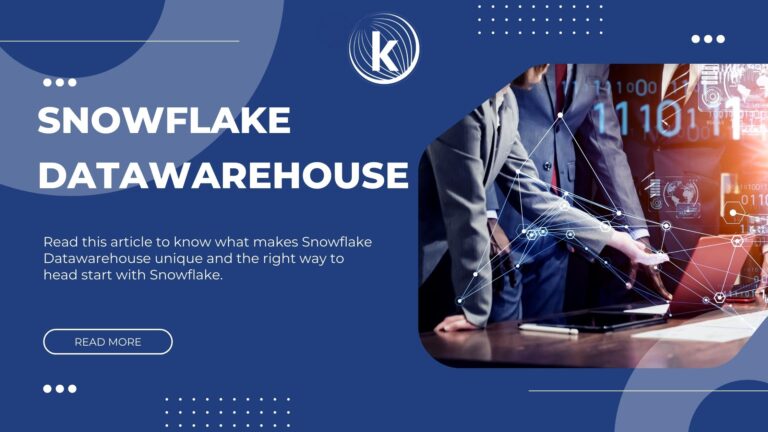With data becoming the lifeblood of businesses, the demand for on-cloud data warehousing is on the rise. Companies are tending towards Datawarehouse models that help scale and manage performance with minimal cost and resources. Here is where Snowflake is emerging as a go-to solution for on-demand cloud data warehousing.
This article provides a closer look at what makes Snowflake Datawarehouse unique and the right way to headstart with Snowflake.
What gives an edge to Snowflake Datawarehouse?
Snowflake warehouse eliminates the age-old mechanism of tying storage and compute. By shifting to Snowflake, businesses can experience seamless scaling in compute, storage, and services besides automating storage and analytics.
In other words, Snowflake offers the zero data management advantage that saves costs and resources for businesses. Additionally:
- Snowflake offers an attractive pay-for-usage model, thus suiting the needs of businesses of all sizes and budgets with limited in-house capabilities and resources to handle and manage data and systems.
- Snowflake offers excellent support to multiple BI tools such as Tableau, Looker, Mode Analytics, Chartio, Qlikview, and Power BI.
- Federated authentication and SSO, and third-party service integration are added advantages with Snowflake.
- Snowflake ecosystem offers a diverse range of solutions fully equipped with rich insights.
- With a simple-to-use and easy to set up intuitive interface, Snowflake caters to organizational needs with unparalleled performance.
- Besides, individuals working on Snowflake can learn and gain support from online resources.
If you have been contemplating building a sustainable enterprise data warehouse with Snowflake, here are the four essential steps to get started:
#1: Assess your rebuilding needs
There is a sea difference in building Snowflake Datawarehouse capability afresh and planning to upgrade the existing on-premise data handling.
Snowflake is a cutting-edge solution to boost the agility and performance of businesses and applications, which is why the infrastructure and technical resources need to be accordingly.
Snowflake offers a pay-per-use model with plenty of affordable options for businesses. Assess the cost, needs, and resource requirements to set up frameworks, tools, and code base for a rough estimate.
#2: Focus on data modeling
One of the cost-effective features of Snowflake is that it eliminates the expensive on-premise data storage.
However, Snowflake comprises various data models with benefits and features of their own. Furthermore, Snowflake caters to diverse requirements such as data lake, data mart, data warehouse, ODS, and database. Its multifarious capabilities – “schema on read” and “schema on write” can seem overwhelming when choosing Snowflake data modeling for the first time.
Hence, it is imperative to choose a data model that best fits your current and future data consumption and business application needs. Usage pattern insights help in data model prediction. For enhanced effectiveness, always seek expert guidance when you want to settle on a data model.
#3: Prepare the ground for ETL tooling
ETL tool partner and integration selection are vital stages in switching to Snowflake. However, it demands quite a groundwork before you proceed to this step:
- Identifying the best data pattern: Batch, near real-time, and real-time – Snowflake Dataware house seamlessly supports all these data integration patterns.
- Evaluate delivery SLAs: Settling on SLAs and ingestion patterns are interlinked. It hence assumes importance to assess data sourcing requirements to predict an appropriate SLA.
- Consider use cases from the long run: Prepare the best possible scenarios in scheduled and disrupted workflows. Consider delays and static dependencies that may disturb the ingestion.
Henceforth, you are all set to choose your Snowflake integration tools and partners. Our Snowflake experts will help evaluate the integration tools against your data volume, processing, and usage.
#4: Get familiarized with Snowflake’s best practices
Once you establish Snowflake Datawarehouse, it helps to gain familiarity with the best practices of handling and managing Snowflake:
- Create role-specific Warehouse actions to restrict unauthorized access or changes to the warehouse. Consider creating different Snowflake Warehouse groups business-wise and application-wise.
- Create billing alerts to enjoy uninterrupted services and monitor billing overage. Alerts help you stay cautious about threshold scenarios and take the appropriate action at the right time.
- Encourage, train and empower your teams with Snowflake policies, user management, data loading practices, and sandboxing.
- Gain the best security from Snowflake’s role-based access control (RBAC). Snowflake also promises security when integrating with third-party tools.

Let Kasmo experts help you with Snowflake
Kasmo envisions eliminating the roadblocks in Snowflake Datawarehouse and Data Analytics for businesses. Our expert and certified consultants have helped global organizations in their data warehousing challenges. Connect with our data experts today to understand how we expedite your business growth.
With Snowflake, your organization can enjoy elevated data interpretation and deliver actionable results. Want our experts to approach you? We are just a message away. Contact us with your data warehousing needs and stay with peace of mind as our experts come up with the best fit solution for your data needs. Hear from our happy customers. Become one of them today! Follow us on LinkedIn.
Read Next: Tableau CRM for Healthcare

